Vienna Philharmonic (coin)
The Vienna Philharmonic, often shortened Philharmonic, is a bullion coin of gold, silver, or platinum, produced by the Austrian Mint (Münze Österreich AG). It is named for the Vienna Philharmonic orchestra (Wiener Philharmoniker), which inspires the design of both sides of the coins. The one troy ounce (ozt) gold version was first introduced in 1989 with a face value of 2,000 Austrian schillings (ATS) and is generally one of the world's best selling bullion coins.[1] [2] In 2002, with the adoption of the euro currency, the nominal value of the one ounce coin was changed to €100. In 2008, the Mint introduced a one-ounce silver version of the coin with a nominal value of €1.50. The silver coin is also one of the top selling bullion coins, ranked third in 2013.[1] In 2016, the mint introduced a one ounce platinum coin with a face value of €100.[3]
Austria | |
| Value | 100 € |
|---|---|
| Mass | 31.103 g |
| Diameter | 37.0 mm |
| Thickness | 2.0 mm |
| Edge | reeded |
| Composition | 99.99% gold |
| Gold | 1.000 troy oz |
| Years of minting | 1989–present |
| Obverse | |
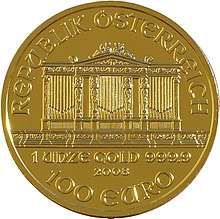 | |
| Design | Musikverein Pipe Organ |
| Designer | Thomas Pesendorfer |
| Design date | 1989 |
| Reverse | |
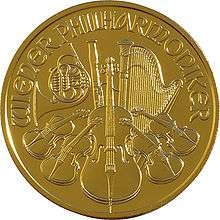 | |
| Design | Orchestra instruments |
| Designer | Thomas Pesendorfer |
Like any bullion coin, the value is based primarily on the metal content and the spot price of that metal on the commodities markets. The gold Philharmonic has a fineness of 999.9 (often written 0.9999, also known as 24 carat or 99.99% pure).[4] In most countries in Europe, the gold Philharmonic is traded VAT-free while the Silver Philharmonic is partly subject to a reduced VAT rate. The coins are minted according to demand and production varies from year to year accordingly. The design on the coin remains the same each year; only the year of issue changes. From the outset, the obverse of the coin depicts the pipe organ in the Vienna Musikverein's Golden Hall. The reverse of the coin shows instruments of the Vienna Philharmonic, including Vienna horn, bassoon, harp, and four violins centered on a cello. Both designs were produced by the chief engraver of the Austrian Mint, Thomas Pesendorfer.
History
The gold Vienna Philharmonic was first offered on October 10, 1989. Initially, it was minted in only two sizes: one troy ounce as well as a quarter ounce. The one tenth and one half ounce coins were added in 1991 and 1994 respectively. All coins feature the same design with the only difference being the weight and face value shown. In 2014, a 1/25 ounce coin was added with a face value of €4.00. The popularity of the Vienna Philharmonic grew quickly: in 1990, the coin was the best selling in Europe and second in the world. In 1992, 1995, 1996 and 2000 the World Gold Council declared it the best-selling gold coin in the world.[4] Since its introduction in October 1989 up to 2012, more than 14 million Philharmonics have been sold for a total weight of 9.6 million ounces or approximately 329 tons of gold.
Since February 1, 2008, a 1-ounce silver version of the coin with a nominal value of €1.50 has been issued, struck from 99.9% pure silver.[5] Unlike the reeded edge of the gold coin, the edge of the silver coin is smooth. Coins are shipped in boxes of 500, called "monster boxes." Each monster box consists of 25 tubes of 20 coins each. Sales of the silver Philharmonic have been brisk with over five million coins sold, equal to 1,800 tons of silver in the 5-year period of 2008 through 2012.
The mint introduced a one ounce platinum coin with the same design as the gold and silver in 2016. Like the gold coin, it has a face value of €100. The purity is shown as 999.5 with the obverse of the coin reading "1 UNZE PLATIN 999.5."[3]
The Vienna Philharmonic is currently the only European bullion coin with a face value in euros, although it is only legal tender in Austria. In 2004, the Vienna Philharmonic accounted for 35 to 40% of sales in Europe. It is also popular in Japan and North America.
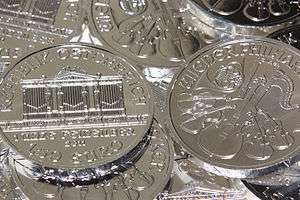
Gold Philharmonic specifications:
| Size | Diameter | Thickness | Weight | Face value | Years minted | |
|---|---|---|---|---|---|---|
| 1/25 ozt | 13.0 mm | 1.2441 g | €4 | from 2014 | ||
| 1/10 ozt | 16.0 mm | 1.2 mm | 3.121 g | €10 | ATS 200 | from 1991 |
| 1/4 ozt | 22.0 mm | 1.2 mm | 7.776 g | €25 | ATS 500 | from 1989 |
| 1/2 ozt | 28.0 mm | 1.6 mm | 15.552 g | €50 | ATS 1,000 | from 1994 |
| 1 ozt | 37.0 mm | 2.0 mm | 31.103 g | €100 | ATS 2,000 | from 1989 |
Silver Philharmonic specifications:
| Size | Diameter | Thickness | Weight | Face value | Years minted |
|---|---|---|---|---|---|
| 1 ozt | 37.0 mm | 3.2 mm | 31.103 g | €1.50 | from 2008 |
Platinum Philharmonic specifications:
| Size | Diameter | Thickness | Weight | Face value | Years minted |
|---|---|---|---|---|---|
| 1 ozt | 37.0 mm | 1.35 mm | 31.10 g | €100.00 | from 2016 |
Big Phil
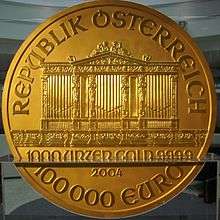
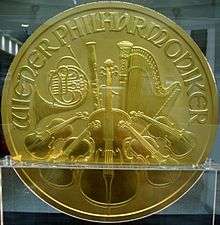
For the 15th anniversary of the Vienna Philharmonic bullion coin in 2004, the Austrian Mint created a 1,000 ounce version with nominal value €100,000.[6] The "Big Phil" coin consists of 31.103 kg of pure gold. Dimensions were increased by tenfold over the one ounce coin yielding a diameter of 37 cm and 2 cm thickness (10 times thicker; 10 times wider; thus 1000 times heavier than the 1 ozt. coin). It was one of the largest coins with the highest denomination until it was eclipsed in 2007 by the Royal Canadian Mint's 100 kg version of the Canadian Gold Maple Leaf with a face value of CA$1,000,000. In keeping with the fifteenth anniversary theme, only fifteen €100,000 Philharmonics were produced. The coin was unveiled in front of the Wiener Riesenrad Ferris wheel in Vienna. One of the coins is displayed in the foyer of the Munich headquarters of precious metals company pro aurum.
20-ounce gold coin
For the 20th anniversary of the Vienna Philharmonic coin, the Austrian Mint created a new size of the coin. This coin has a face value of €2,000 and a fine weight of 20 troy ounces or 622 grams. The diameter is 74 mm with a thickness of 8.3 mm. At the time of issue in October 2009, the material value was around €14,000. Due to the limited minting, the coin was sold at a premium of approximately 10% above gold price. The total circulation of these coins was 6,027 (providing 2,009 coins in each of the European, American, and Japanese markets), which were sold in velvet-lined wooden cases with certificates.[7]
1/25 ounce gold coin
For the 25th anniversary of the Vienna Philharmonic gold coin series in 2014, the mint went in a different direction, creating the diminutive 1/25 ounce version of the coin, featuring the same design, but with a face value of €4.00. Also in celebration of the 25th anniversary, 5,000 proof sets of the 1 ounce and 1/4 ounce coins (the two original sizes) were produced.[8] Production of the 1/25th ounce coin continued in 2015.
Production
Gold Philharmonic (Schilling)
| Year[9] | 1/10 ozt | 1/4 ozt | 1/2 ozt | 1 ozt |
|---|---|---|---|---|
| 1989 | – | 272,000 | – | 351,000 |
| 1990 | – | 162,000 | – | 484,500 |
| 1991 | 82,500 | 146,000 | – | 233,500 |
| 1992 | 99,000 | 176,000 | – | 537,000 |
| 1993 | 99,500 | 126,000 | – | 234,000 |
| 1994 | 112,000 | 121,200 | 94,700 | 218,600 |
| 1995 | 151,100 | 156,000 | 57,400 | 645,500 |
| 1996 | 128,300 | 139,200 | 88,000 | 377,600 |
| 1997 | 115,300 | 100,700 | 68,200 | 408,300 |
| 1998 | 102,800 | 90,800 | 47,300 | 330,300 |
| 1999 | 145,000 | 81,600 | 44,200 | 230,700 |
| 2000 | 32,600 | 25,900 | 20,500 | 245,700 |
| 2001 | 26,400 | 25,800 | 26,800 | 54,700 |
Gold Philharmonic (euros)
| Year[4] | 1/25 ozt | 1/10 ozt | 1/4 ozt | 1/2 ozt | 1 ozt |
|---|---|---|---|---|---|
| 2002 | – | 75,789 | 40,807 | 40,922 | 164,105 |
| 2003 | – | 59,654 | 34,019 | 26,848 | 179,881 |
| 2004 | – | 67,994 | 32,449 | 24,269 | 176,319 |
| 2005 | – | 62,071 | 32,817 | 21,049 | 158,564 |
| 2006 | – | 39,892 | 29,609 | 20,085 | 82,174 |
| 2007 | – | 76,325 | 34,631 | 25,091 | 108,675 |
| 2008[10] | – | 176,682 | 97,090 | 73,778 | 715,842 |
| 2009[10] | – | 437,706 | 171,992 | 92,249 | 903,047 |
| 2010[10] | – | 226,685 | 84,968 | 56,607 | 501,951 |
| 2011[10] | – | 272,227 | 102,026 | 73,488 | 586,686 |
| 2012[10] | – | 176,262 | 64,314 | 49,483 | 341,411 |
| 2013[11] | – | 193,115 | 77,219 | 69,573 | 579,223 |
| 2014[12][10] | 78,551 | 147,461 | 68,440 | 57,816 | 418,919 |
| 2015[10] | 88,157 | 263,439 | 112,228 | 101,500 | 647,100 |
| 2016[10] | 67,915 | 181,536 | 91,809 | 78,460 | 451,007 |
| 2017[10] | 40,186 | 131,815 | 65,086 | 52,281 | 355,436 |
| 2018[10] | 44,637 | 116,932 | 46,080 | 44,750 | 318,334 |
| 2019[10] | 44,023 | 100,697 | 56,199 | 40,890 | 164,312 |
Silver Philharmonic
| Year[5] | 1 ozt |
|---|---|
| 2008 | 7,773,000 |
| 2009 | 9,014,800 |
| 2010 | 11,358,200 |
| 2011 | 17,873,700 |
| 2012 | 8,769,200 |
| 2013 | 14,536,400 |
| 2014 | 4,643,508 |
| 2015 | 7,298,593 |
| 2016 | 3,448,390 |
| 2017 | 2,064,804 |
| 2018 | 2,101,592 |
See also
References
- "Top Official Coin Sales: Market Overwhelmingly Chooses Silver". http://srsroccoreport.com. SRSrocco Report. 12 May 2014. Retrieved 31 May 2014.
The Gold Maple Leaf sales took first place at 1,140,000 oz while the Gold Eagle came in second at 856,500 oz, followed by an estimated 750,000 oz of South African Krugerrands, 544,000 oz of Gold Philharmonics, and 460,082 Gold Pandas.
External link in|website=(help) - "Gold coin sales from national Mints fall in Q1". https://www.reuters.com. Reuters. 26 June 2012. Retrieved 31 May 2014.
The United States, Canadian and Austrian Mints, which between them produce three of the world's top five bullion investment coins, all reported lower sales in the first quarter of 2012 versus a year ago.
External link in|website=(help) - "Austrian Mint Issues First Platinum Coin, Part of the Prestigious Vienna Philharmonic Range". http://www.prnewswire.com. PR Newswire. 8 February 2016. Retrieved 10 February 2016.
The Austrian Mint has issued a new platinum Vienna Philharmonic coin as the latest addition to its internationally renowned coin range. Unveiled at the Berlin Coin Fair, the coin marks the Austrian Mint's first platinum offering.
External link in|website=(help) - "The Vienna Philharmonic Gold 1 oz Coin". The Austrian Mint. Retrieved 2014-05-10.
- "The Vienna Philharmonic Silver 1 oz Coin". The Austrian Mint. Retrieved 2014-05-10.
- Dobnik, Verena (10 October 2004). "Austria's new coin valued at $500,000". The Houston Chronicle. Associated Press. Retrieved 31 May 2014.
- "Gold Philharmonic 20th Anniversary Commemorate Coin". CoinNews.net. Retrieved 2014-05-10.
- "Two-coin Proof Quality Set 25th Anniversary of the Vienna Philharmonic Gold Coin". Austrian Mint. Retrieved 2014-05-10.
- Wiener Philharmoniker (Münze), Retrieved 2014-05-10
- https://www.muenzeoesterreich.at/eng/Produkte/1-Ounce-fine-gold-999.9 Web site: Other products in series → … → Learn more → Mintage
- "Annual Report 2013" (PDF). Austrian Mint. Retrieved 2014-07-01.
- "Annual Report 2014" (PDF). Austrian Mint. Retrieved 2015-09-29.